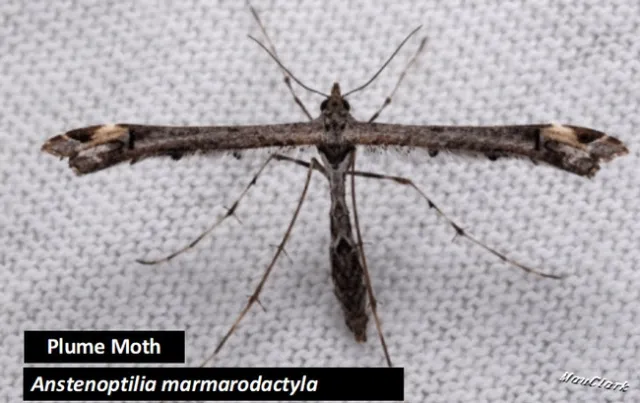Ahh the Plume Moth…. How often do people walk by this little moth and wondered what it is or not see it at all? This moth has a distinctive ‘T” shaped body. They have long legs and usually with spines at their joints. Their unusual modified wings are interesting, and look like the wings of an airplane. They have very skinny wings with a wingspan of ½ - 1½ inches. This moth comes in muted shades of tan, brown and gray. The hind wings usually have three lobes, and when they are rest, they roll them up. This allows them to disguise themselves to look like a small twig or dead vegetation. When their wings are open, the have the appearance of a bird's plume. Some species have pleated wings that look like an opera cloak. They are not good fliers and are usually found near the plant that feeds their larvae.

Plume Moths are part of the Lepidoptera Order and the Pterophoridae family. They are seen throughout the world and we have several species that are native to CA, AZ and south through Mexico to Costa Rica. There are approximately 150 species in North America, north of Mexico.
This moth is most active at night and are attracted to porch lights. In the morning, it common to see them resting on the sides of buildings. During the day, plume moths prefer to rest on nonwoody plants or flowers. They are most commonly seen spring through fall, during the warm months.
The Plume moth likes to feed on nectar and pollen such as the Monardella villosa (Coyote Mint) and Salvia spathacea (Hummingbird Sage). Both of which are California native plants and members of the Mint Family. Plume moths could also be expected to feed on other native species of the same family. They can visit over 20 different plant families, including Asteraceae (Sunflower, Ragweed, Thistles), Vitaceae (Wild Grapes), and Convolvulaceae (Morning Glories, Dodder).
Plume moths typically lay their eggs on underside of young leaves at a plant's tip. Newly-hatched larvae are slow, hairy, spindle-shaped, leaf rollers, root-borers or leaf-miners that feed within their chosen shelter. Older caterpillars may bore into the plant's stem, flowers or seed pods.
The life cycle depends of the species of plume moth. There can be several broods each year. Some larvae pupate underground or in ground litter, while others attached themselves to plants, bare and without a cocoon, and then other larvae species will create a cocoon.
The larvae of many of these small moths are food specialists. Some use their powers for good and some do not. On the negative side are the larvae of the Grape Vine Plume, which web together the terminal leaves of grapevines and feed inside (but don't cause significant harm) and the larvae of the Artichoke Plume, which start outside the choke but eat their way toward its heart (found nationwide), it eats thistles where it can't find artichokes. Other larvae include the Snapdragon and the Geranium Plumes. Some Plume moth larvae prefer to feed on Agastache (Licorice Mint, Hyssop), Ageratum (Floss Flower), Antirrhinum (Snapdragon), Pelargonium (Geranium),Salvia (Sage), Mentha (Mint), Lantana species, Pycnanthemum (Mountain Mint), and Scrophularia family (Figworts).
Some helpful “T moths” have been imported as biological controls for plants running amok in their adopted countries. These include the Horehound Plume, introduced to Australia to control invasive horehound that is covering pastures and waste places there, and the Ragwort Plume, brought to New Zealand to eat imported Senecio in wetlands. There is a Plume moth for Conoclinium (Blue Mistflower, Hardy Ageratum), Lantana, and Senecio vulgaris (Common Groundsel). There also is a Convolvulus arvensis (Bindweed) Plume moth that has been introduced to the US to control that serious weed of agricultural and open places.
Plume moths are apparently relished by many predators, such as birds, that hunt by sight.

